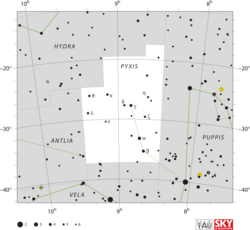Astronomy:Theta Pyxidis
| Observation data Equinox J2000.0]] (ICRS) | |
|---|---|
| Constellation | Pyxis |
| Right ascension | 09h 21m 29.60s[1] |
| Declination | –25° 57′ 55.5″[1] |
| Apparent magnitude (V) | 4.718[2] |
| Characteristics | |
| Spectral type | M0.5 III Ba0.5[3] |
| U−B color index | +1.984[2] |
| B−V color index | +1.651[2] |
| Variable type | semiregular variable[4] |
| Astrometry | |
| Radial velocity (Rv) | +20.0±2.8[5] km/s |
| Proper motion (μ) | RA: –12.24 ± 0.40[1] mas/yr Dec.: –9.29 ± 0.37[1] mas/yr |
| Parallax (π) | 6.49 ± 0.45[1] mas |
| Distance | 500 ± 30 ly (150 ± 10 pc) |
| Absolute magnitude (MV) | −1.22[6] |
| Details | |
| Radius | 54[7] R☉ |
| Luminosity | 970[8] L☉ |
| Temperature | 3,825[8] K |
| Other designations | |
| Database references | |
| SIMBAD | data |
Theta Pyxidis, Latinized from θ Pyxidis, is a red M-type giant in the constellation Pyxis. It is approximately 500 ± 30 light years from Earth.[1] It is of spectral type M1III and semi-regular variable with two measured periods of 13 and 98.3 days, and an average visual magnitude of 4.71,[4] It shines with a luminosity approximately 970 times that of the Sun and has a surface temperature of 3825 K.[8] It has a diameter around 54 times that of the Sun.[7]
Theta Pyxidis is moving through the Galaxy at a speed of 22.8 km/s relative to the Sun. Its projected Galactic orbit carries it between 21,200 and 24,700 light years from the center of the Galaxy. It came closest to the Sun 5.8 million years ago when it had brightened to magnitude 3.12 from a distance of 241 light years.[citation needed]
References
- ↑ Jump up to: 1.0 1.1 1.2 1.3 1.4 1.5 van Leeuwen, F. (November 2007), "Validation of the new Hipparcos reduction", Astronomy and Astrophysics 474 (2): 653–664, doi:10.1051/0004-6361:20078357, Bibcode: 2007A&A...474..653V
- ↑ Jump up to: 2.0 2.1 2.2 Gutierrez-Moreno, Adelina et al. (1966), "A System of photometric standards", Publications of the Department of Astronomy University of Chile (Publicaciones Universidad de Chile, Department de Astronomy) 1: 1–17, Bibcode: 1966PDAUC...1....1G.
- ↑ Keenan, Philip C.; McNeil, Raymond C. (1989). "The Perkins catalog of revised MK types for the cooler stars". Astrophysical Journal Supplement Series 71: 245. doi:10.1086/191373. Bibcode: 1989ApJS...71..245K.
- ↑ Jump up to: 4.0 4.1 Tabur, V.; Bedding, T.R. (2009). "Long-term photometry and periods for 261 nearby pulsating M giants". Monthly Notices of the Royal Astronomical Society 400 (4): 1945–61. doi:10.1111/j.1365-2966.2009.15588.x. Bibcode: 2009MNRAS.400.1945T.
- ↑ de Bruijne, J. H. J.; Eilers, A.-C. (October 2012), "Radial velocities for the HIPPARCOS-Gaia Hundred-Thousand-Proper-Motion project", Astronomy & Astrophysics 546: 14, doi:10.1051/0004-6361/201219219, A61, Bibcode: 2012A&A...546A..61D.
- ↑ Anderson, E.; Francis, Ch. (2012), "XHIP: An extended hipparcos compilation", Astronomy Letters 38 (5): 331, doi:10.1134/S1063773712050015, Bibcode: 2012AstL...38..331A.
- ↑ Jump up to: 7.0 7.1 Pasinetti Fracassini, L. E.; Pastori, L.; Covino, S.; Pozzi, A. (2001). "Catalogue of Apparent Diameters and Absolute Radii of Stars (CADARS) - Third edition - Comments and statistics". Astronomy & Astrophysics 367 (2): 521–24. doi:10.1051/0004-6361:20000451. Bibcode: 2001A&A...367..521P.
- ↑ Jump up to: 8.0 8.1 8.2 McDonald, I.; Zijlstra, A. A.; Boyer, M. L. (2012). "Fundamental Parameters and Infrared Excesses of Hipparcos Stars". Monthly Notices of the Royal Astronomical Society 427 (1): 343–57. doi:10.1111/j.1365-2966.2012.21873.x. Bibcode: 2012MNRAS.427..343M.
 |


